The Use of Artificial Neural Networks to Determine the Engine Power and Fuel Consumption of Modern Bulk Carriers, Tankers and Container Ships
Abstract
1. Introduction
- Financial benefit, which consists of the amount of cargo transported and the duration of transportation;
- The cost of transporting the cargo, which consists primarily of the cost of energy supplied to the ship.
- The transport efficiency of the ship, such as deadweight and vessel speed;
- The energy efficiency of the ship, affected by the total power and fuel consumption of the vessel.
- E—the transport efficiency, DWT—deadweight capacity, V—speed, and P—total engine power.
- Geometrically similar ship methods based on the British Admiralty coefficient;
- Use of technical diagrams, for example, MAN B&W Diesel diagrams [11].
2. Background
2.1. The Estimation of Propulsion Power
2.2. The Estimation of Fuel Consumption
2.3. Cargo Capacity and Ship Velocity as Design Parameters
- Deadweight carriers, where deadweight capacity is a critical design characteristic—tankers and bulk carriers are typical representatives of this ship category;
- Volume carriers, where hold volume capacity is the most important design characteristic—RO-RO cargo ships, car carriers, and container vessels are representative of this ship category.
- Maximum possible deadweight tonnage for tankers and bulk carriers, which corresponds to fully loaded deadweight at full summer saltwater draught (normally of 1025 t/m3 density);
- Maximum number of TEU containers that could be carried by a container ship,
- The design speed of a tanker, bulk carrier or container ship.
2.4. The Aims of Research
- DWT—maximum possible deadweight tonnage which corresponds to fully loaded deadweight at full summer saltwater draught (normally of 1025 t/m3 density), for tankers and bulk carriers;
- TEU—maximum number of TEU containers that could be carried by a container ship;
- V—design speed of a tanker, bulk carrier and container ship;
- MCR—maximum continuous rating (i.e., maximum power output of an engine that can be produced while running continuously at safe limits and conditions);
- FC—the daily heavy fuel consumption of main engines;
- f1, f2—approximating functions.
3. Materials and Methods
3.1. Data
- 276 tankers;
- 196 bulk carriers;
- 81 container ships.
3.2. General Research Framework
- ○
- The type and complexity of the ANN topology, which affects the complexity of the mathematical form;
- ○
- ANN characteristics, which influence the phenomena of overfitting.
3.3. Artificial Neural Networks
- xi—input values;
- wi—weight;
- b—bias,
- S—sum.
- Purelin (where the neuron activation is passed directly on as the output):
- Standard logistic function:
- Data used for network training—the training set;
- Data used for network validation during training—the validation set;
- Data used for network testing only—the test set.
4. Results and Analysis
4.1. Design Equations Developed through the Use of Artificial Neural Networks
- Multilayer perceptron (MLP) with a single hidden layer and the standard logistic activation functions presented in Equation (6);
- Linear network (LN) with the purelin activation functions presented in Equation (5).
- Bulk carriers:
- Tankers:
- Container carriers:where:
- MCR is engine power (kW);
- FC is fuel consumption (t/day);
- DWT is deadweight capacity (t);
- TEU is the number of containers;
- V is velocity (kts).
- (a)
- the engine power of the following vessels, which were calculated as:
- Bulk carriers, 1016, 1060, 1559 and 1163 kW for training, validation, test and all sets, respectively;
- Tankers, 1761, 1456, 1647 and 1656 kW for training, validation, test and all sets, respectively;
- Container carriers, 5137, 4233, 7012 and 5380 kW for training, validation, test and all sets, respectively.
- (b)
- The fuel consumption of the following vessels were calculated as:
- Bulk carriers, 6.0, 5.1, 6.6 and 5.9 t/day for training, validation, test and all sets, respectively;
- Tankers, 9.8, 8.3, 7.4 and 8.8 t/day for training, validation, test and all sets, respectively;
- Container carriers, 24.3, 24.1, 19.5 and 23.1 t/day for training, validation, test and all sets, respectively;
- 0.97 for training, validation, test and all datasets of the ANN estimating the engine power of bulk carriers;
- 0.93, 0.95, 0.94 and 0.94 for training, validation, test and all datasets, respectively, of the ANN estimating the fuel consumption of bulk carriers;
- 0.97, 0.98, 0.97 and 0.97 for training, validation, test and all datasets, respectively, of the ANN estimating the engine power of tankers;
- 0.92, 0.97, 0.96 and 0.94 for training, validation, test and all datasets, respectively, of the ANN estimating the fuel consumption of tankers;
- 0.95, 0.98, 0.93 and 0.96 for training, validation, test and all datasets, respectively, of the ANN estimating the engine power of container carriers;
- 0.92, 0.95, 0.95 and 0.94 for training, validation, test and all datasets, respectively, of the ANN estimating the fuel consumption of container carriers.
- From −600 to 1500 kW and from −9 to 6 t/day for the ANN estimating the engine power and fuel consumption of bulk carriers, respectively;
- From −1000 to 1600 kW and from −10 to 9 t/day for the ANN estimating the engine power and fuel consumption of tankers, respectively;
- From −600 to 3900 kW and from −7 to 31 t/day for the ANN estimating the engine power and fuel consumption of container carriers, respectively.
4.2. An Example Application
- A bulk carrier with a 35,000 t DWT capacity and a speed V of 15 kts.;
- A tanker with a 100,000 t DWT capacity and a speed V of 14 kts.;
- A container carrier with a 10,000 TEU and a speed V of 23 kts.
- CO2—CO2 emission;
- CF—conversion factor (Table 7).
- Directly using Equations (8), (10) and (12);
- Indirectly using the MCR estimated by Equations (7), (9) and (11) and then using the following equation:where:FC = 24 ⋅ MCR ⋅ sfc ⋅ 10−6
- FC—daily fuel consumption of the main engine [t/day];
- MCR—maximum continues rate [kW];
- sfc—specific fuel consumption of the main engine [g/kWh].
- A bulk carrier by using Equation (8) equals:
- A tanker by using Equation (10) equals:
- A container carrier by using Equation (12) equals:
- A bulk carrier equals:CO2 = 3.114 ⋅ 26.17 = 81.48 t CO2/day,
- A tanker equals:CO2 = 3.114 ⋅ 38.35 = 119.44 t CO2/day,
- A bulk carrier equals:CO2 = 3.114 ⋅ 153.71 = 478.65 t CO2/day.
- A bulk carrier by using Equation (7) equals:
- A tanker by using Equation (9) equals:
- A container carrier by using Equation (11) equals:
- 131–176 g/kWh for bulk carriers;
- 136–170 g/kWh for tankers;
- 134–176 g/kWh for container carriers.
- A bulk carrier equals:CO2 = 3.114 ⋅ 24 ⋅ 6996.41 ⋅ 150 ⋅ 10−6 = 78.43 t CO2/day,
- A tanker equals:CO2 = 3.114 ⋅ 24 ⋅ 11,201.91 ⋅ 150 ⋅ 10−6 = 125.58 t CO2/day,
- A bulk carrier equals:CO2 = 3.114 ⋅ 24 ⋅ 42,598.53 ⋅ 150 ⋅ 10−6 = 477.55 t CO2/day.
5. Discussion
6. Conclusions
Limitation of the Study
- From −600 to 1500 kW and from −9 to 6 t/day for the ANN estimating the engine power and fuel consumption of bulk carriers, respectively;
- From −1000 to 1600 kW and from −10 to 9 t/day for the ANN estimating the engine power and fuel consumption of tankers, respectively;
- From −600 to 3900 kW and from −7 to 31 t/day for the ANN estimating the engine power and fuel consumption of container carriers, respectively.
Author Contributions
Funding
Institutional Review Board Statement
Informed Consent Statement
Data Availability Statement
Conflicts of Interest
Abbreviations
| ANN | artificial neural network |
| BP | error back propagation algorithm |
| CF | conversion factor |
| CG | conjugate gradient algorithm |
| CO2 | carbon dioxide |
| DWT | deadweight capacity |
| FC | daily heavy fuel consumption of main engines |
| Fn | Froude number |
| IMO | International Maritime Organization |
| LBP | length between perpendiculars |
| LN | linear neural network |
| MCR | maximum continuous rating, total engine power |
| MLP | multilayer perceptron |
| PCC | Pearson correlation coefficient |
| PI | pseudo-inverse algorithm |
| RMSE | root mean square error |
| sfc | specific fuel consumption |
| TEU | twenty-foot equivalent unit |
| V | ship velocity |
References
- Rawson, K.J.; Tupper, E.C. Basic Ship Theory. Ship Dynamics and Design, 5th ed.; Butterworth-Heinemann: Oxford, UK, 2001; Volume 2. [Google Scholar]
- Watson, D.G.M. Practical Ship Design; Elsevier Science: Oxford, UK, 1998; Volume 1. [Google Scholar]
- Papanikolaou, A. Ship Design: Methodologies of Preliminary Design; Springer: Dordrecht, The Netherlands, 2014. [Google Scholar]
- Song, S.K.; Shon, Z.H. Current and future emission estimates of exhaust gases and particles from shipping at the largest port in Korea. Environ. Sci. Pollut. Res. 2014, 21, 6612–6622. [Google Scholar] [CrossRef]
- Eyring, V.; Isaksen, I.; Berntsen, T.; Collins, W.; Corbett, J.; Endresen, O.; Grainger, R.; Moldanova, J.; Schlager, H.; Stevenson, D. Transport impacts on atmosphere and climate: Shipping. Atmos. Environ. 2009, 44, 4735–4771. [Google Scholar] [CrossRef]
- Coello, J.; Williams, I.; Hudson, D.A.; Kemp, S. An AIS-based approach to calculate atmospheric emissions from the UK fishing fleet. Atmos. Environ. 2015, 114, 1–7. [Google Scholar] [CrossRef]
- Nunes, R.A.O.; Alvim-Ferraz, M.C.M.; Martins, F.G.; Sousa, S.I.V. The activity-based methodology to assess ship emissions—A review. Environ. Pollut. 2017, 231, 87–103. [Google Scholar] [CrossRef] [PubMed]
- Czermański, E.; Cirella, G.T.; Oniszczuk-Jastrząbek, A.; Pawłowska, B.; Notteboom, T. An Energy Consumption Approach to Estimate Air Emission Reductions in Container Shipping. Energies 2021, 14, 278. [Google Scholar] [CrossRef]
- Ekincia, S.; Celebia, U.B.; Bala, M.; Amasyalia, M.F.; Boyacia, K. Predictions of oil/chemical tanker main design parameters using computational intelligence techniques. Appl. Soft Comput. 2011, 11, 2356–2366. [Google Scholar] [CrossRef]
- Lin, C.; Shaw, H. Feature-based estimation of preliminary costs in shipbuilding. Ocean. Eng. 2017, 144, 305–319. [Google Scholar] [CrossRef]
- MAN Diesel & Turbo. Propulsion Trends in Tankers; MAN Diesel & Turbo: Copenhagen, Denmark, 2007. [Google Scholar]
- Petersen, J.P.; Jacobsen, D.J.; Winther, O. Statistical modelling for ship propulsion efficiency. J. Mar. Sci. Technol. 2012, 17, 30–39. [Google Scholar] [CrossRef]
- Celik, F.; Erturk, I.; Turan, E. Investigation of main particulars subject to minimum building cost for chemical tankers. Ocean. Eng. 2013, 73, 32–37. [Google Scholar] [CrossRef]
- Schneekluth, H.; Bertram, V. Ship Design for Efficiency and Economy, 2nd ed.; Butterworth-Heinemann: Oxford, UK, 1998. [Google Scholar]
- Piko, G.P. Regression Analysis of Ship Characteristics; Thompson Commonwealth Government Printer: Canberra, Australia, 1980. [Google Scholar]
- Żelazny, K. Method for Determination of Service Speed Useful in the Initial Design of Cargo Vessels under Statistical Weather Conditions Occurring on Shipping Route; West Pomeranian University of Technology, Publishing House: Szczecin, Poland, 2015. (In Polish) [Google Scholar]
- Kim, K.-S.; Roh, M.-I. ISO 15016:2015-Based Method for Estimating the Fuel Oil Consumption of a Ship. J. Mar. Sci. Eng. 2020, 8, 791. [Google Scholar] [CrossRef]
- ISO. ISO 15016:2015-Ship and Marine Technology—Guidelines for the Assessment of Speed and Power Performance by Analysis of Speed Trial Data; ISO: Geneva, Switzerland, 2015. [Google Scholar]
- ITTC. Recommended Procedures and Guidelines—Preparation, Conduct and Analysis of Speed/Power Trials; ITTC: Zürich, Switzerland, 2017. [Google Scholar]
- Bialystocki, N.; Konovessis, D. On the estimation of ship’s fuel consumption and speed curve: A statistical approach. J. Ocean. Eng. Sci. 2016, 1, 157–166. [Google Scholar] [CrossRef]
- Bal Beşikçi, E.; Arslan, O.; Turan, O.; Ölçer, A.I. An artificial neural network based decision support system for energy efficient ship operations. Comput. Oper. Res. 2016, 66, 393–401. [Google Scholar] [CrossRef]
- Simonsen, M.; Walnum, H.J.; Gössling, S. Model for Estimation of Fuel Consumption of Cruise Ships. Energies 2018, 11, 1059. [Google Scholar] [CrossRef]
- Townsin, R.L.; Kwon, Y.J. Estimating the Influence of Weather on Ship Performance; Wind Press: Milano, Italy, 1993; Volume 135, pp. 191–209. [Google Scholar]
- Lin, Y.-H.; Fang, M.-C.; Yeung, R.W. The optimization of ship weather-routing algorithm based on the composite influence of multi-dynamic elements. Appl. Ocean Res. 2013, 43, 184–194. [Google Scholar] [CrossRef]
- Vettor, R.; Soares, C.G. Development of a ship weather routing system. Ocean Eng. 2016, 123, 1–14. [Google Scholar] [CrossRef]
- Park, J.; Kim, N. Two-Phase Approach to OptimalWeather Routing Using Real-Time Adaptive A* Algorithm and Geometric Programming. J. Ocean Eng. Technol. 2015, 29, 263–269. [Google Scholar] [CrossRef][Green Version]
- Roh, M.-I. Determination of an economical shipping route considering the e_ects of sea state for lower fuel consumption. Int. J. Nav. Arch. Ocean Eng. 2013, 5, 246–262. [Google Scholar] [CrossRef]
- Wei, S.; Zhou, P. Development of a 3D Dynamic Programming Method for Weather Routing. In Methods and Algorithms in Navigation: Marine Navigation and Safety of Sea Transportation; CRC Press: Boca Raton, FL, USA, 2011; Volume 6, pp. 181–187. [Google Scholar]
- Chen, H. Voyage Optimization Supersedes Weather Routing; Jeppesen Marine Inc.: Denver, CO, USA, 2011; pp. 1–11. [Google Scholar]
- ISO. ISO 15016:2002-Ship and Marine Technology—Guidelines for the Assessment of Speed and Power Performance by Analysis of Speed Trial Data; ISO: Geneva, Switzerland, 2002. [Google Scholar]
- Eniram. Fuel Saving; Eniram: Helsinki, Finland, 2008. [Google Scholar]
- Samsung. Samsung Heavy Industries Energy Efficiency Management System; Samsung: Seoul, Korea, 2017. [Google Scholar]
- Soultanias, I. Parametric Ship Design and Holistic Design Optimization of a 9000 TEU Container Carrier; National Technical University of Athens: Athens, Greece, 2014. [Google Scholar]
- Nikolopoulosa, L.; Boulougourisb, E. A novel method for the holistic, simulation driven ship design optimization under uncertainty in the big data era. Ocean. Eng. 2020, 218, 107634. [Google Scholar] [CrossRef]
- Alkan, A.D.; Gulez, K.; Yilmaz, H. Design of a robust neural network structure for determining initial stability particulars of fishing vessels. Ocean. Eng. 2004, 31, 761–777. [Google Scholar] [CrossRef]
- Gurgen, S.; Altin, I.; Murat, O. Prediction of main particulars of a chemical tanker at preliminary ship design using artificial neural network. Ships Offshore Struct. 2018, 13, 459–465. [Google Scholar] [CrossRef]
- Abramowski, T. Application of Artificial Intelligence Methods to Preliminary Design of Ships and Ship Performance Optimization. Nav. Eng. J. 2013, 125, 101–112. [Google Scholar]
- Sahin, V.; Vardar, N. Determination of Wastewater Behavior of Large Passenger Ships Based on Their Main Parameters in the Pre-Design Stage. J. Mar. Sci. Eng. 2020, 8, 546. [Google Scholar] [CrossRef]
- Le, L.T.; Lee, G.; Park, K.; Kim, H. Neural network-based fuel consumption estimation for container ships in Korea. Marit. Policy Manag. 2020, 47, 615–632. [Google Scholar] [CrossRef]
- Cheng, X.; Chen, S.; Diao, C. Simplifying Neural Network Based Model for Ship Motion Prediction: A Comparative Study of Sensitivity Analysis. In Proceedings of the ASME 2017 36th International Conference on Ocean, Offshore and Arctic Engineering, Trondheim, Norway, 25–30 June 2017; Volume 1, p. V001T01A016. [Google Scholar]
- Sea-Web Ships. 2018. Available online: https://maritime.ihs.com (accessed on 10 February 2018).
- Haykin, S. Neural Networks: A Comprehensive Foundation; Macmillan Publishing: New York, NY, USA, 1994. [Google Scholar]
- Fausett, L. Fundamentals of Neural Networks; Prentice Hall: New York, NY, USA, 1994. [Google Scholar]
- Patterson, D. Artificial Neural Networks; Prentice Hall: Singapore, 1996. [Google Scholar]
- Bishop, C. Neural Networks for Pattern Recognition; University Press: Oxford, UK, 1995. [Google Scholar]
- Shepherd, J. Second-Order Methods for Neural Networks; Springer: New York, NY, USA, 1997. [Google Scholar]
- Broyden, C.G. The convergence of a class of double-rank minimization algorithms 1. General considerations. IMA J. Appl. Math. 1970, 6, 76–90. [Google Scholar] [CrossRef]
- Fletcher, R. A new approach to variable metric algorithms. Comput. J. 1970, 13, 317–322. [Google Scholar] [CrossRef]
- Shanno, D.F. Conditioning of quasi-newton methods for function minimization. Math. Comput. 1970, 24, 647–656. [Google Scholar] [CrossRef]
- Goldfarb, D. A family of variable-metric methods derived by variational means. Math. Comput. 1970, 24, 23–26. [Google Scholar] [CrossRef]
- TIBCO Software Inc. Statistica (Data Analysis Software System), version 13; TIBCO Software Inc.: Palo Alto, CA, USA, 2017. [Google Scholar]
- Hunter, D.; Yu, H.; Pukish, M.S.; Kolbusz, J.; Wilamowski, B.M. Selection of proper neural network sizes and architectures—A comparative study. IEEE Trans. Ind. Inf. 2012, 8, 228–240. [Google Scholar] [CrossRef]
- International Maritime Organization: MEPC.245(66). 2014 Guidelines on the Method of Calculation of the Attained Energy Efficiency Design Index (EEDI) for New Ships; IMO: London, UK, 2014. [Google Scholar]
- Polski Rejestr Statków. Guidlines of Energy Efficiency of Ships; Publication No. 103/P; Polski Rejestr Statków: Gdansk, Poland, 2017. [Google Scholar]


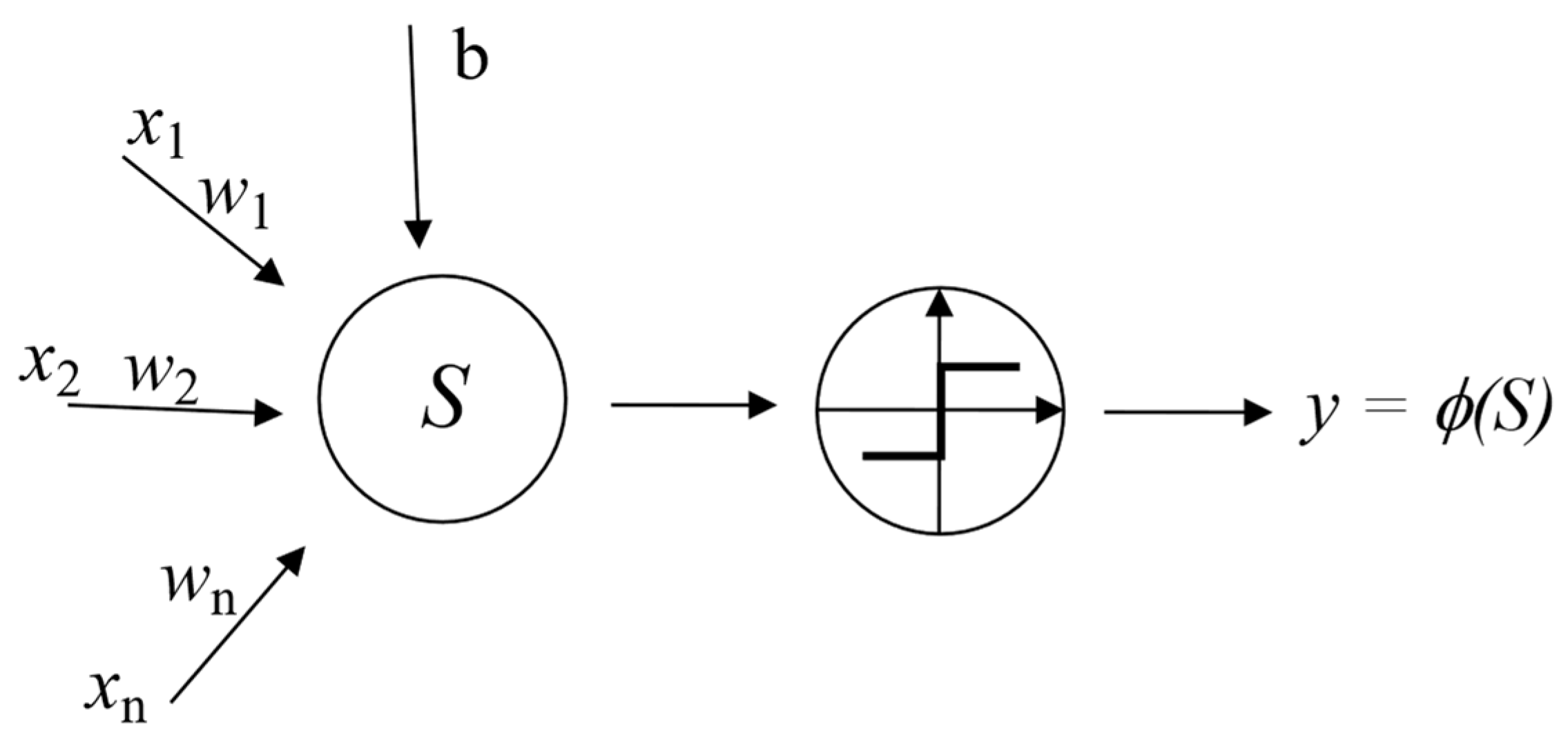
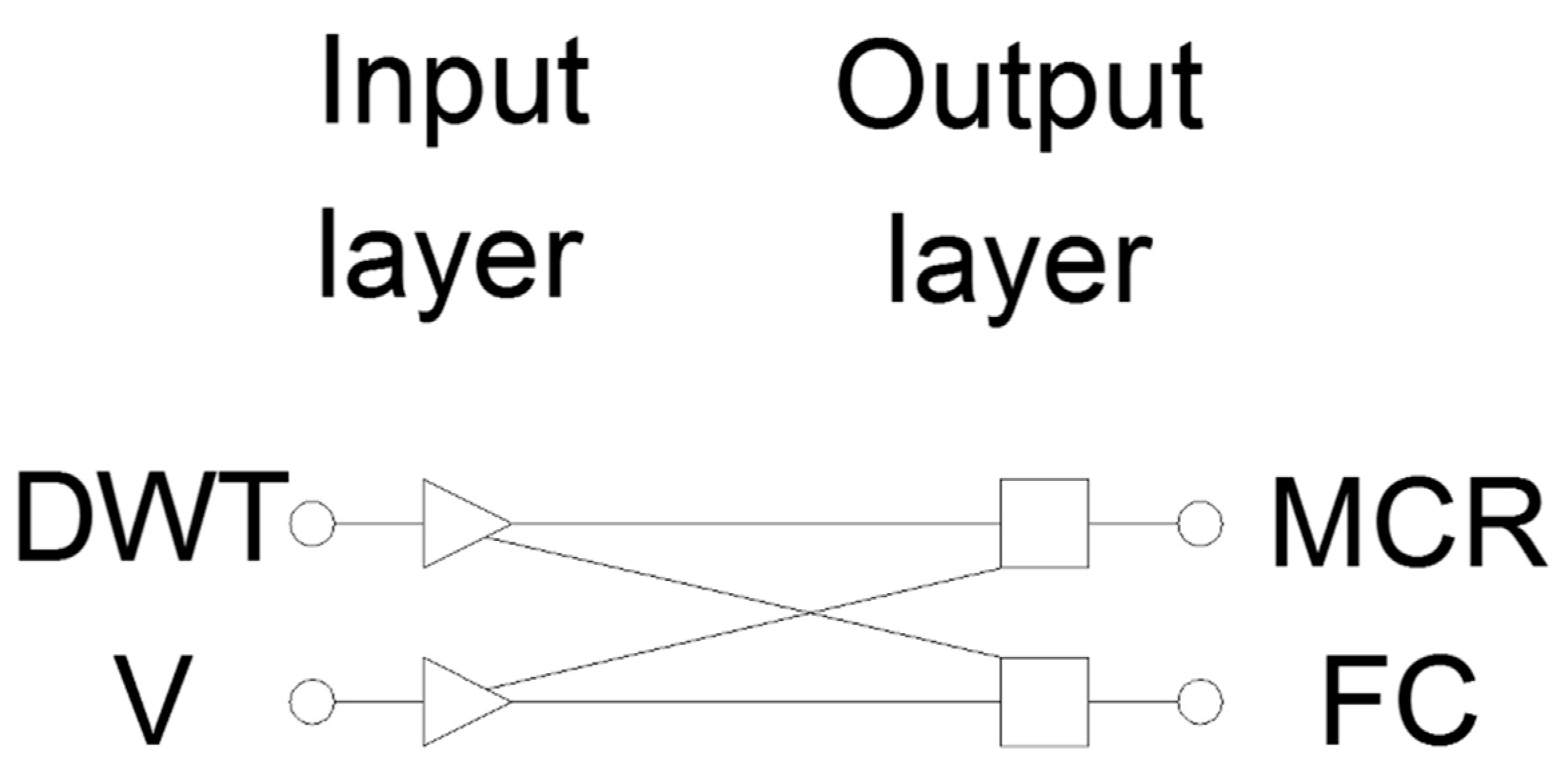
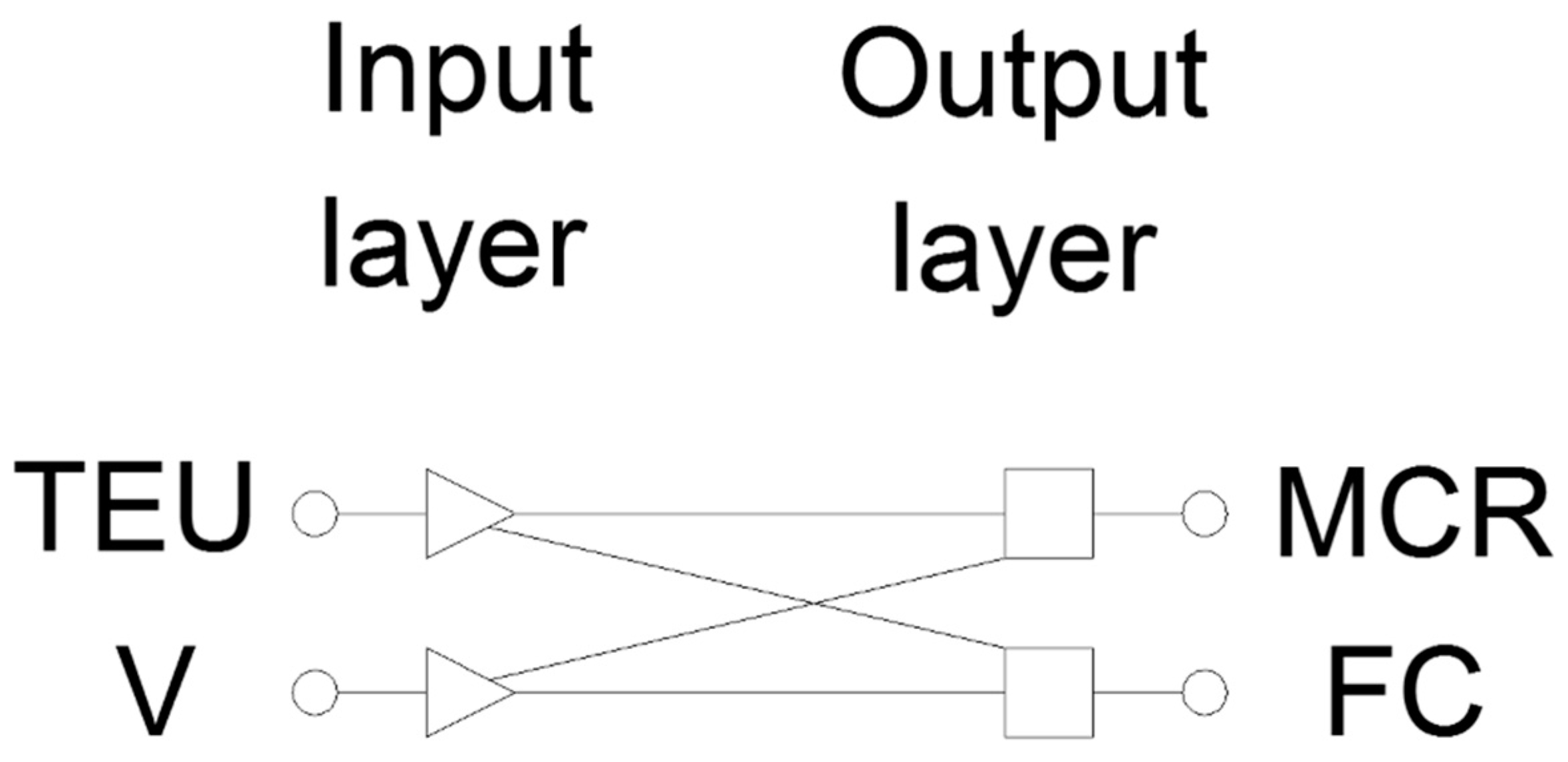
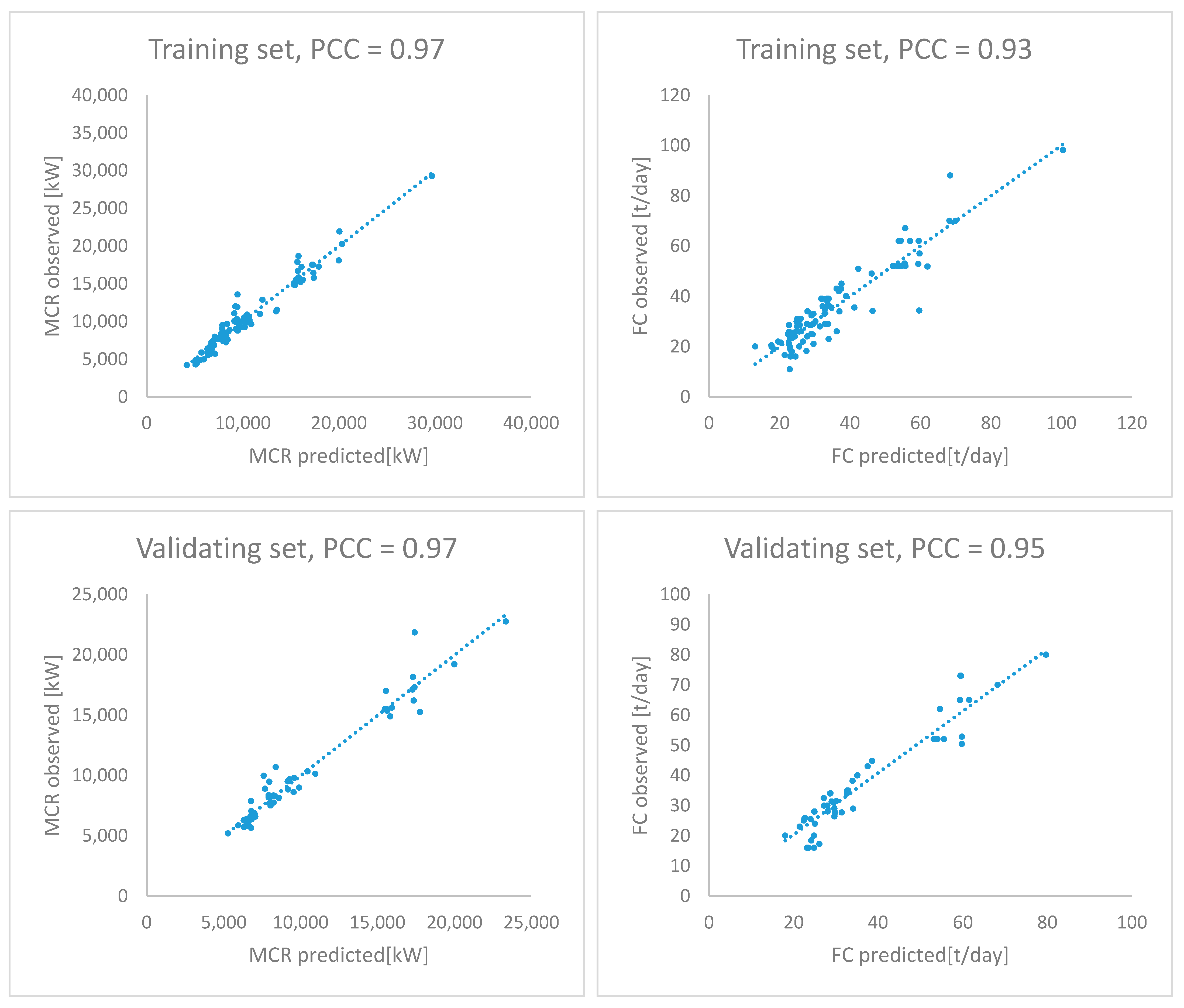
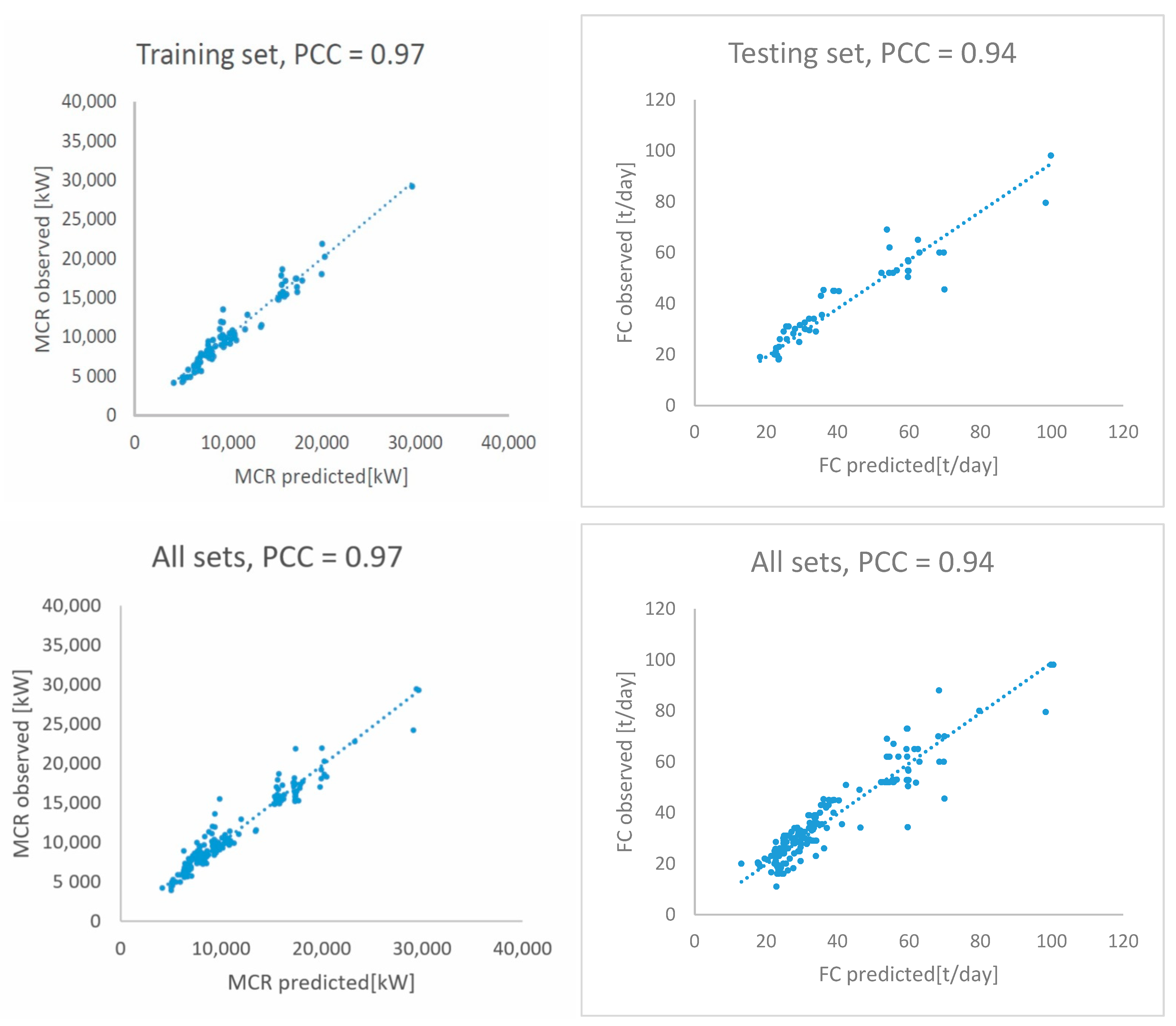
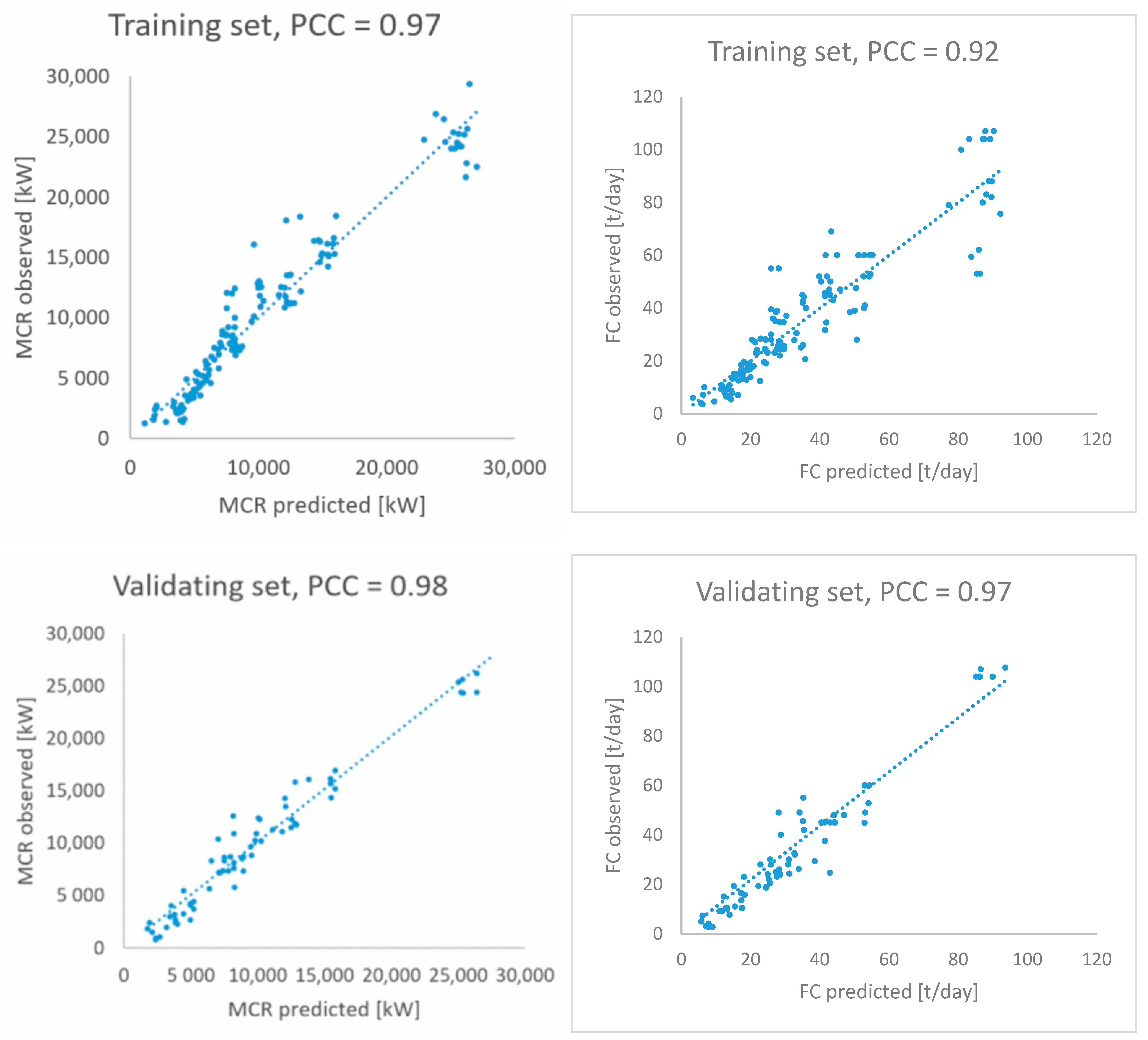
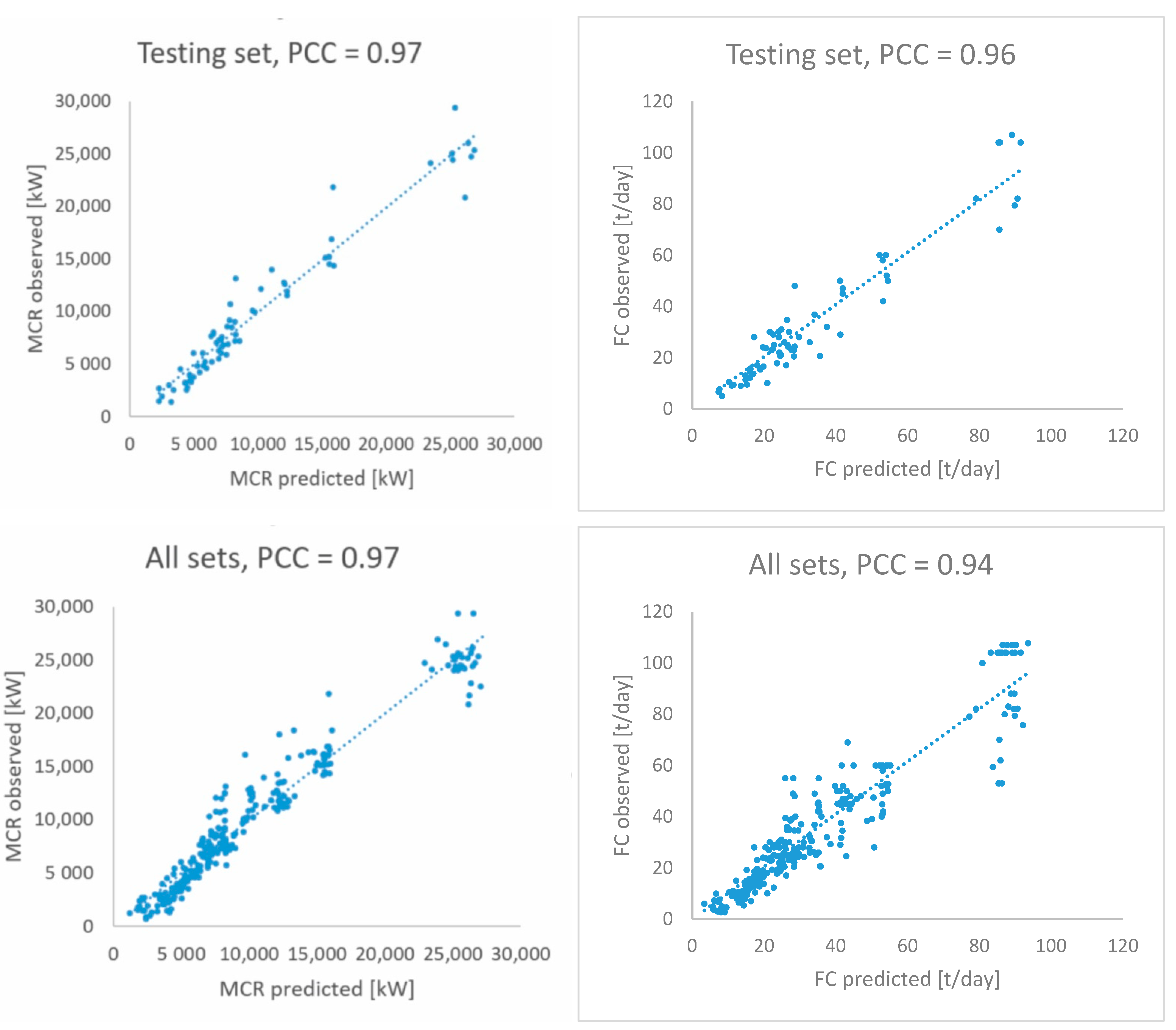

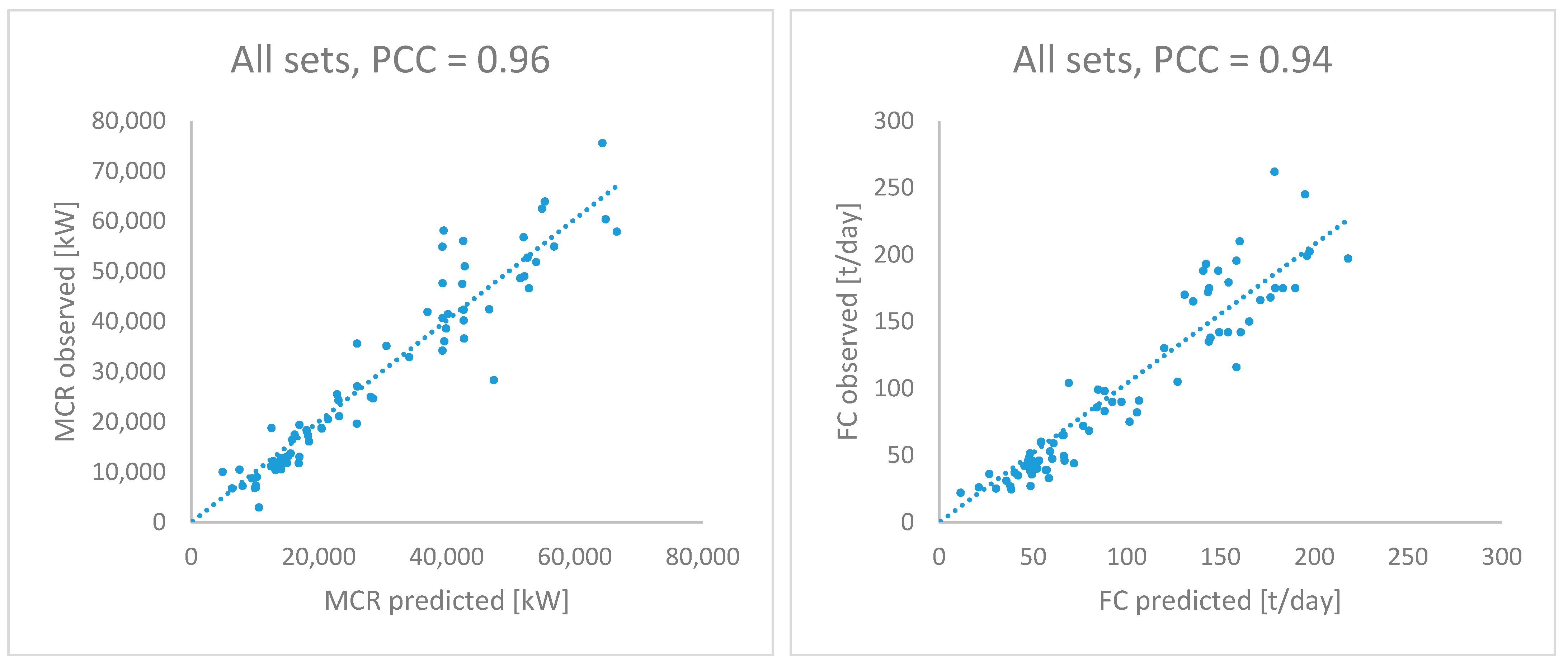
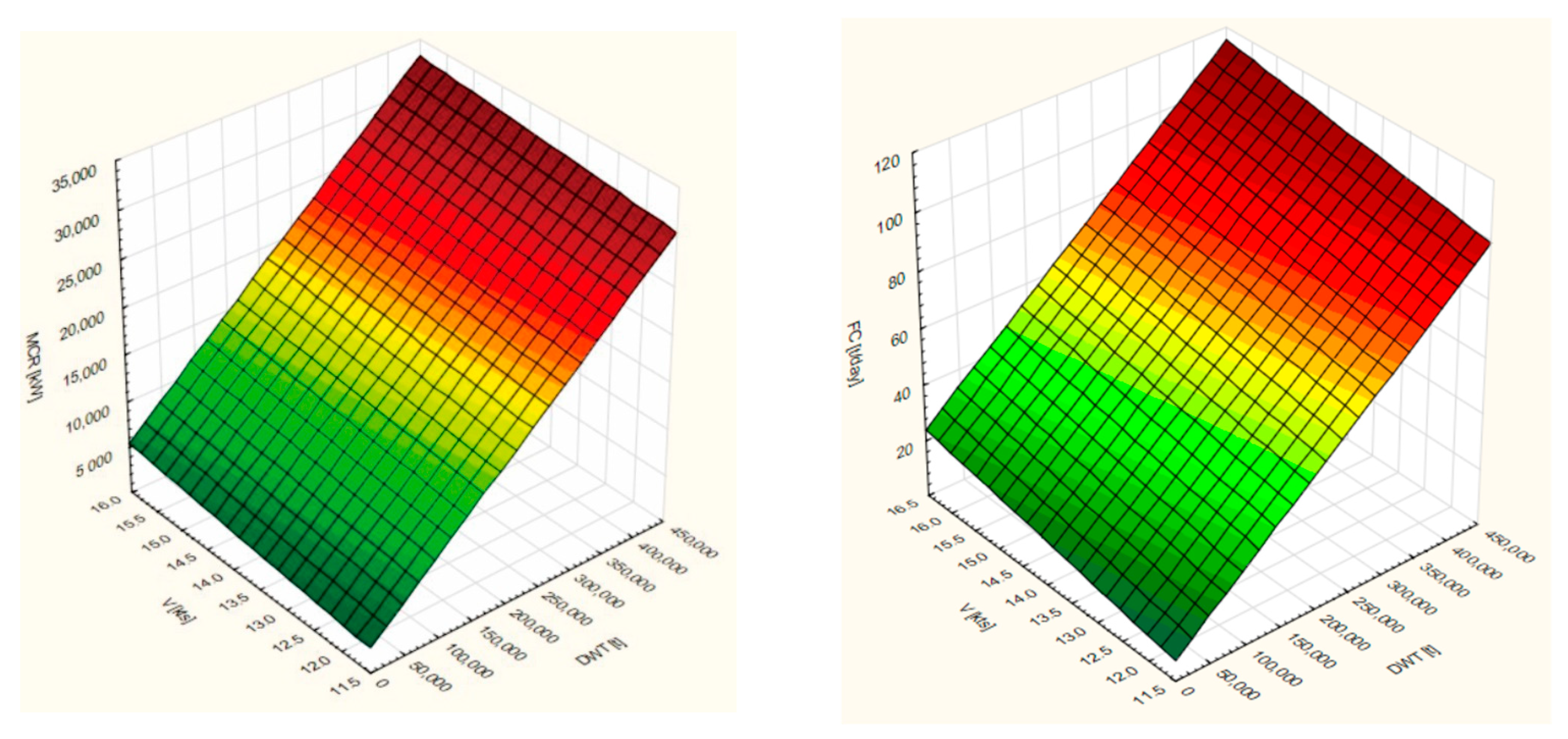
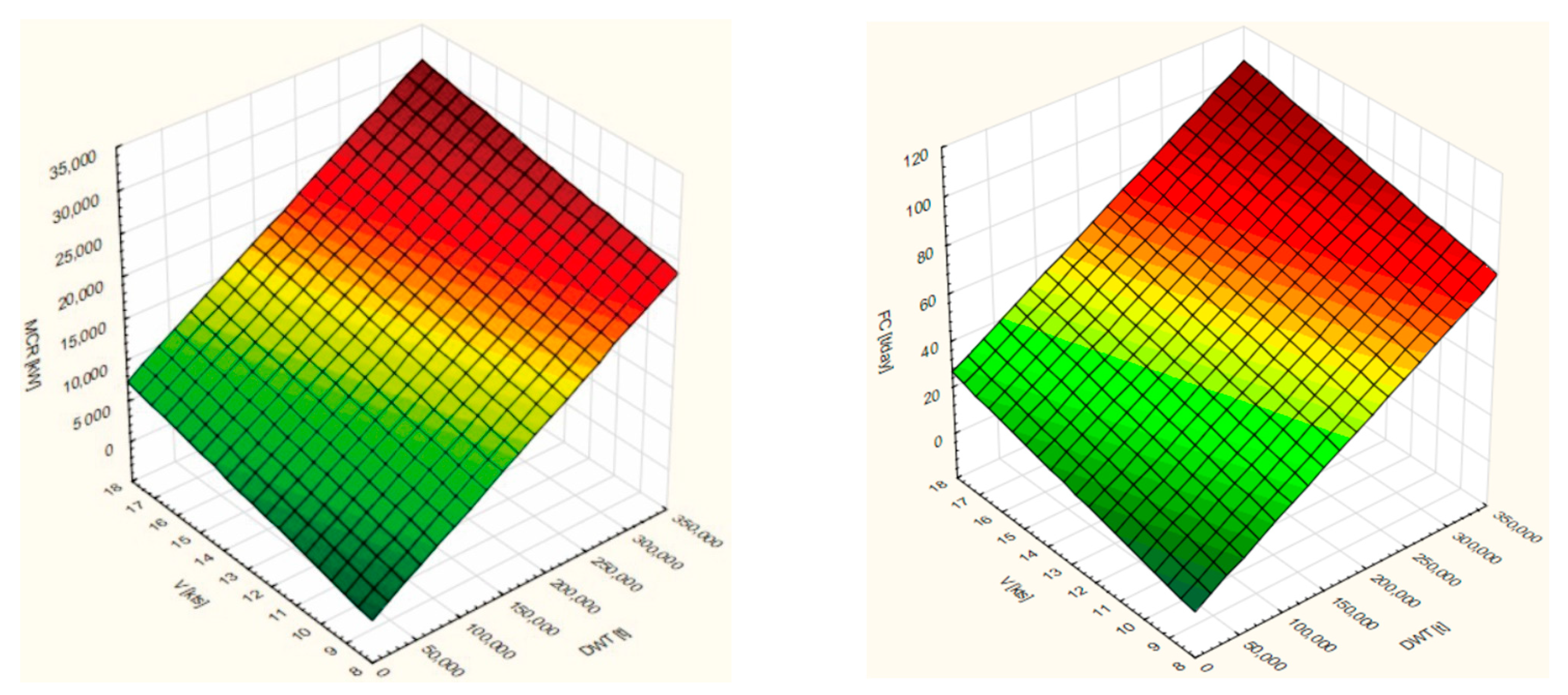
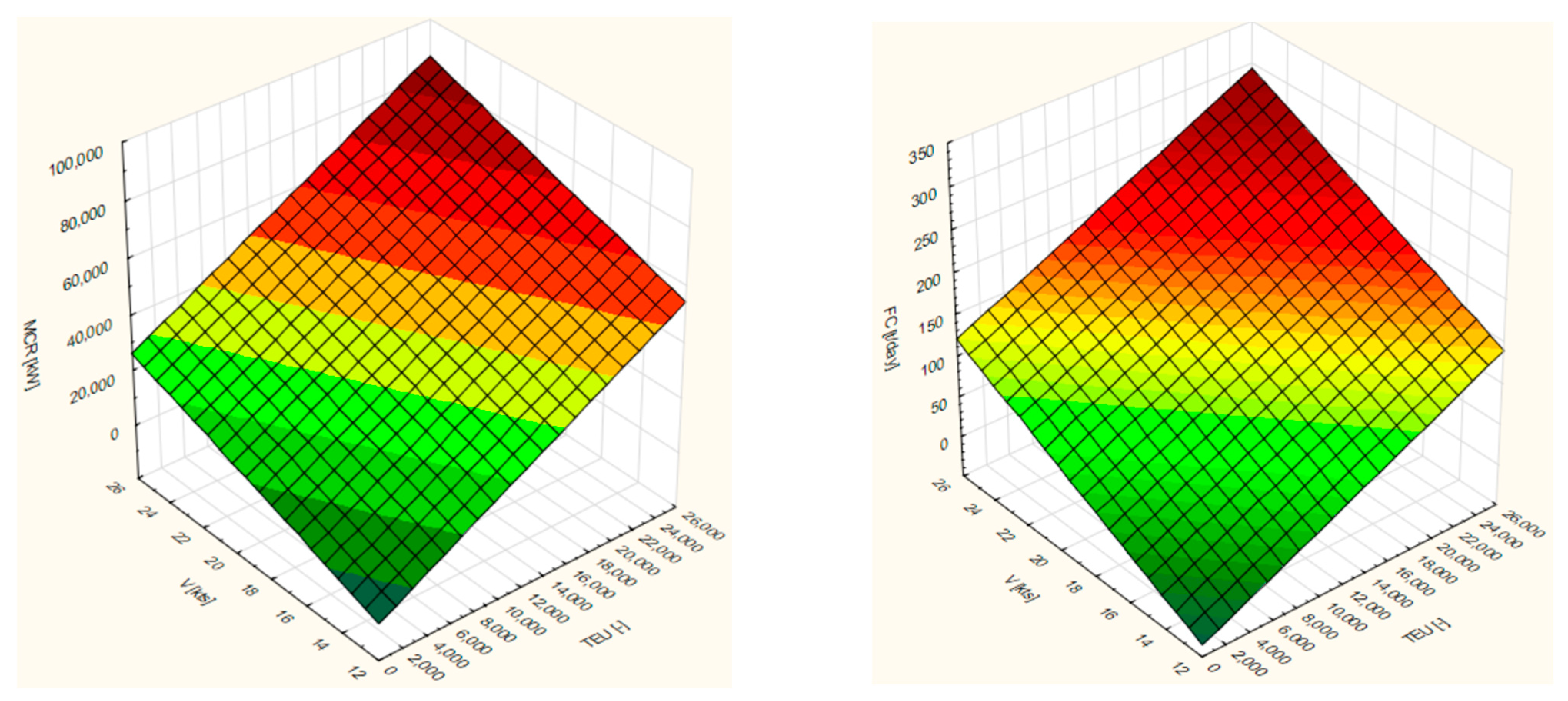

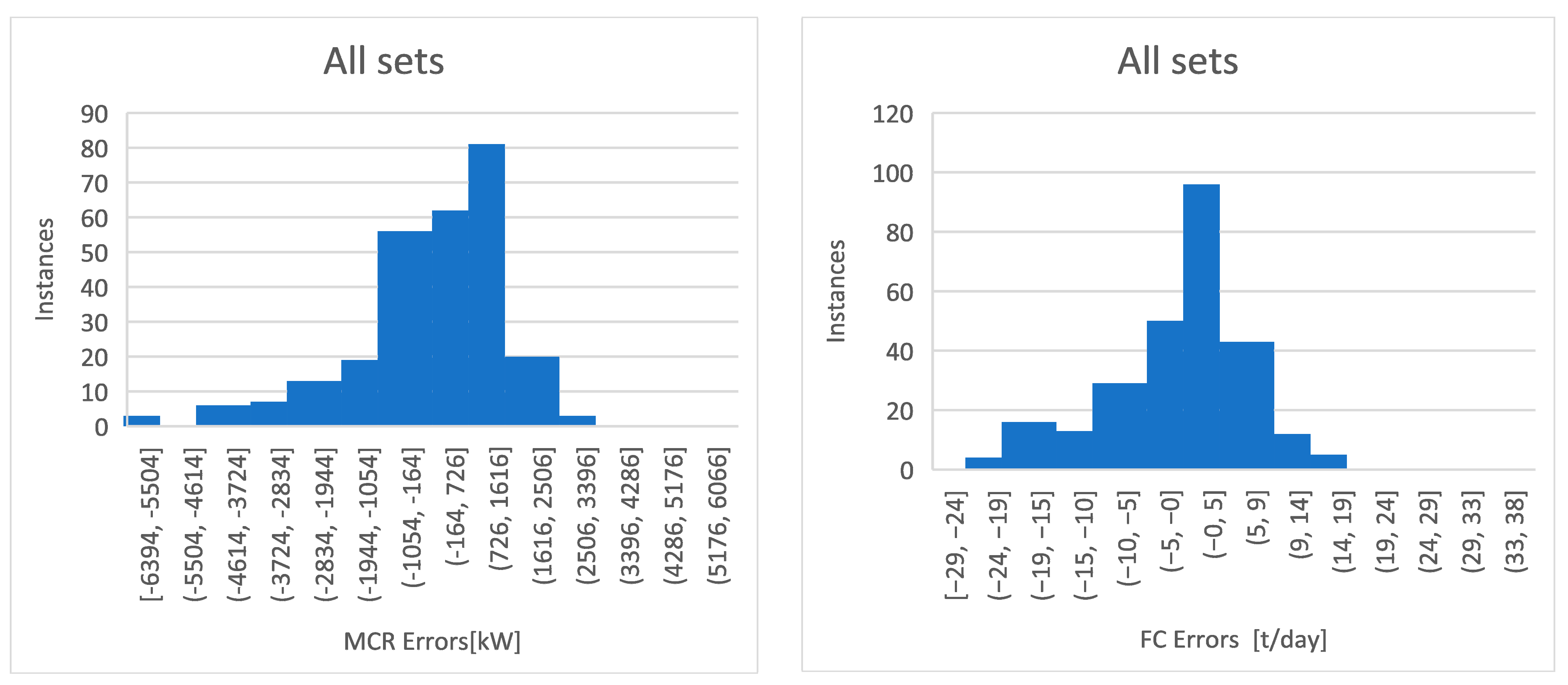
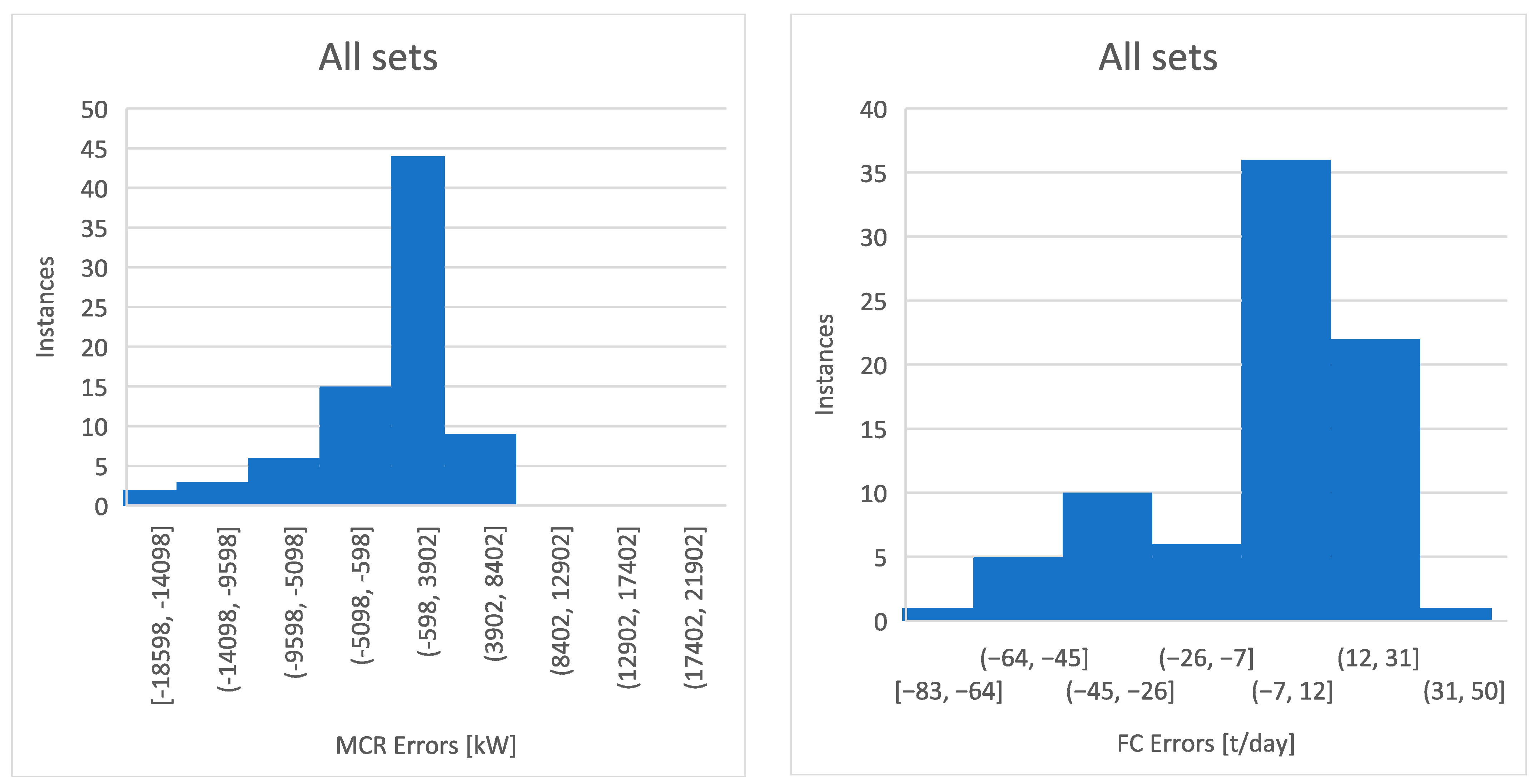
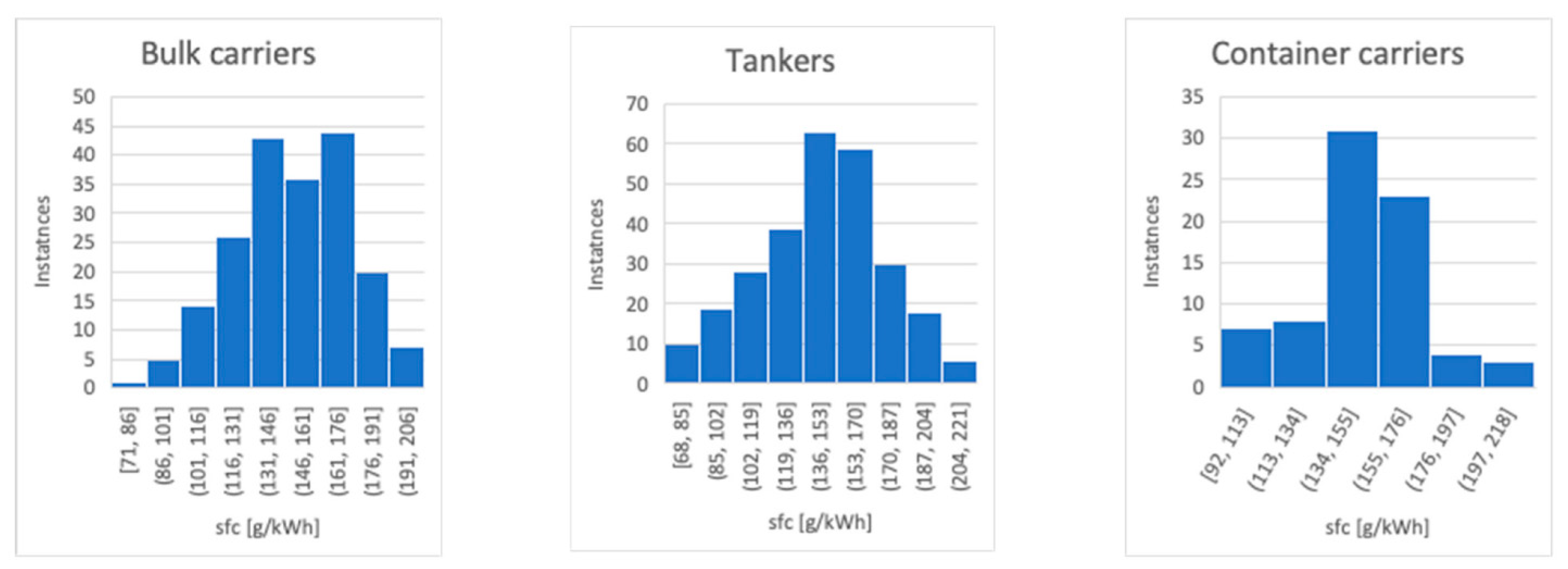

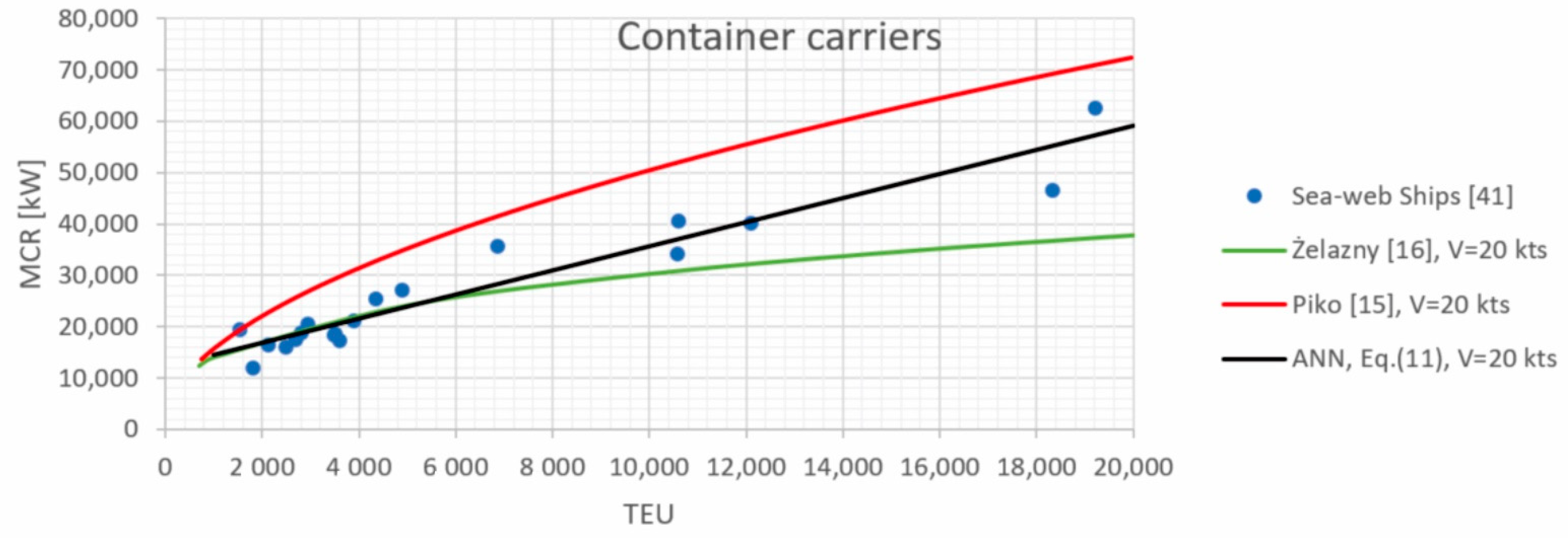
| DWT [t] | V [kts] | LBP [m] | Fn [−] | MCR [kW] | FC [t/Day] | |
|---|---|---|---|---|---|---|
| Min | 16,102 | 12 | 130.0 | 0.13 | 3900 | 11 |
| Max | 403,508 | 15.5 | 353.5 | 0.20 | 29,400 | 98.1 |
| Mean | 101,891.6 | 14.3 | 224.6 | 0.16 | 10,627.8 | 37.4 |
| DWT [t] | V [kts] | LBP [m] | Fn [−] | MCR [kW] | FC [t/Day] | |
|---|---|---|---|---|---|---|
| Min | 877 | 9 | 47.0 | 0.10 | 735 | 2.7 |
| Max | 320,899 | 16.9 | 334.9 | 0.28 | 31,620 | 107.7 |
| Mean | 83,605.3 | 14.0 | 190.9 | 0.18 | 10,114.5 | 35.1 |
| TEU [−] | V [kts] | LBP [m] | Fn [−] | MCR [kW] | FC [t/Day] | |
|---|---|---|---|---|---|---|
| Min | 707 | 13 | 126.8 | 0.15 | 2925 | 20 |
| Max | 23,964 | 24.5 | 386.2 | 0.26 | 75,570 | 262 |
| Mean | 6426 | 19.9 | 233.7 | 0.22 | 27,071.7 | 97.7 |
| No | Network Type | Number of Neurons in Hidden Layers | RMSE | Training Method/Number of Training Epochs | ||||
|---|---|---|---|---|---|---|---|---|
| Training Set | Validation Set | Test Set | All Sets | |||||
| 1 | LN | - | MCR [kW] | 1016 | 1060 | 1559 | 1163 | PI |
| FC [t/day] | 6.0 | 5.1 | 6.6 | 5.9 | ||||
| 2 | MLP | 15 | MCR [kW] | 1057 | 1096 | 1481 | 1173 | BP/50 |
| FC [t/day] | 6.2 | 5.3 | 6.3 | 6.0 | ||||
| 3 | MLP | 23 | MCR [kW] | 1068 | 1143 | 1481 | 1190 | BP/50,CG2 |
| FC [t/day] | 6.3 | 5.5 | 6.3 | 6.1 | ||||
| 4 | MLP | 19 | MCR [kW] | 1202 | 1346 | 1429 | 1295 | BP/50,CG/53 |
| FC [t/day] | 7.1 | 6.5 | 6.0 | 6.7 | ||||
| 5 | MLP | 23 | MCR [kW] | 1389 | 1429 | 1832 | 1510 | BP/38 |
| FC [t/day] | 8.2 | 6.9 | 7.7 | 7.7 | ||||
| 6 | MLP | 23 | MCR [kW] | 1669 | 1894 | 2079 | 1828 | BP/50,CG/7 |
| FC [t/day] | 9.8 | 9.1 | 8.8 | 9.4 | ||||
| No | Network Type | Number of Neurons in Hidden Layers | RMSE [−] | Training Method/Number of Training Epochs | ||||
|---|---|---|---|---|---|---|---|---|
| Training Set | Validation Set | Test Set | All Sets | |||||
| 1 | LN | - | MCR [kW] | 1761 | 1456 | 1647 | 1656 | PI |
| FC [t/day] | 9.8 | 8.3 | 7.4 | 8.8 | ||||
| 2 | MLP | 23 | MCR [kW] | 1751 | 1498 | 1671 | 1667 | BP/50 |
| FC [t/day] | 9.8 | 8.5 | 7.6 | 8.9 | ||||
| 3 | MLP | 35 | MCR [kW] | 1857 | 1498 | 1805 | 1754 | BP/12 |
| FC [t/day] | 10.4 | 8.5 | 8.2 | 9.4 | ||||
| 4 | MLP | 53 | MCR [kW] | 1857 | 1498 | 1757 | 1742 | BP/47 |
| FC [t/day] | 10.4 | 8.5 | 7.9 | 9.3 | ||||
| No | Network Type | Number of Neurons in Hidden Layers | RMSE [−] | Training Method/Number of Training Epochs | ||||
|---|---|---|---|---|---|---|---|---|
| Training Set | Validation Set | Test Set | All Sets | |||||
| 1 | LN | - | MCR [kW] | 5137 | 4233 | 7012 | 5380 | PI |
| FC [t/day] | 24.3 | 24.1 | 19.5 | 23.1 | ||||
| 2 | MLP | 13 | MCR [kW] | 5400 | 4274 | 7340 | 5604 | BP/50,CG/1 |
| FC [t/day] | 25.6 | 24.3 | 20.4 | 24.0 | ||||
| 3 | MLP | 5 | MCR [kW] | 5817 | 4357 | 7410 | 5850 | BP/50,CG/58 |
| FC [t/day] | 27.5 | 24.8 | 20.6 | 25.1 | ||||
| 4 | MLP | 20 | MCR [kW] | 5589 | 4364 | 7454 | 5749 | BP/38 |
| FC [t/day] | 26.5 | 24.8 | 20.7 | 24.6 | ||||
| Type of Fuel Oil | CF (t-CO2/t-Fuel) |
|---|---|
| Diesel | 3.206 |
| Light Fuel | 3.151 |
| Heavy Fuel | 3.114 |
Publisher’s Note: MDPI stays neutral with regard to jurisdictional claims in published maps and institutional affiliations. |
© 2021 by the authors. Licensee MDPI, Basel, Switzerland. This article is an open access article distributed under the terms and conditions of the Creative Commons Attribution (CC BY) license (https://creativecommons.org/licenses/by/4.0/).
Share and Cite
Cepowski, T.; Chorab, P. The Use of Artificial Neural Networks to Determine the Engine Power and Fuel Consumption of Modern Bulk Carriers, Tankers and Container Ships. Energies 2021, 14, 4827. https://doi.org/10.3390/en14164827
Cepowski T, Chorab P. The Use of Artificial Neural Networks to Determine the Engine Power and Fuel Consumption of Modern Bulk Carriers, Tankers and Container Ships. Energies. 2021; 14(16):4827. https://doi.org/10.3390/en14164827
Chicago/Turabian StyleCepowski, Tomasz, and Paweł Chorab. 2021. "The Use of Artificial Neural Networks to Determine the Engine Power and Fuel Consumption of Modern Bulk Carriers, Tankers and Container Ships" Energies 14, no. 16: 4827. https://doi.org/10.3390/en14164827
APA StyleCepowski, T., & Chorab, P. (2021). The Use of Artificial Neural Networks to Determine the Engine Power and Fuel Consumption of Modern Bulk Carriers, Tankers and Container Ships. Energies, 14(16), 4827. https://doi.org/10.3390/en14164827





